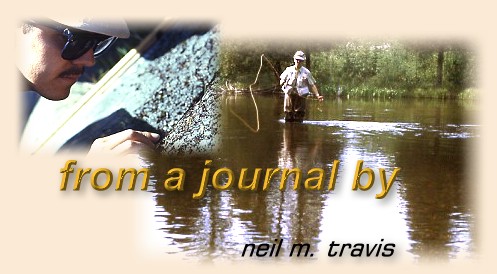Canoe Casting
By Neil M. Travis, Montana
My wife is an amputee, the victim of a malicious
cancer that destroyed the muscles in her left leg.
For the past 9 years this has restricted her
movements to places that she can maneuver on her
forearm crutches. This has limited our previously
active outdoor lifestyle, and our hiking is limited
to short hikes on smooth trails or forest roads.
Climbing through the timber, hiking to high mountain
lakes, or similar activities that we once enjoyed are
now relegated to the past. Fortunately we have always
enjoyed canoeing and her physical limitations have
not prevented her from sitting in the front of our
canoe, and still being able to enjoy the beauty of
nature.
Despite my obvious addiction to everything involving
fly-fishing it is a singular affliction and one not
shared by my wife. Early on in our married life she
made a few attempts at the sport, but the fishing bug
never bite her very hard, and she has remained
uninfected by the fly-fishing virus. After nearly 45
years I have little hope that she will ever succumb,
however, when we go canoeing she insists that I take
my fly rod in case there might be a chance for me to
fish.
One of our favorite lakes is a long narrow lake in
the mountains near our home that was formed by a
landslide several decades ago. Much of the lake is
studded with dead standing timber, and the bottom
is littered with the remains of fallen trees. Trout,
some of them of considerable size, roam the lake,
but they are hard to fool and even more difficult
to land. The difficulty rests on several factors,
and therein lays the challenge.
Since it is a high mountain lake the hatches are
limited to a very few insects. Midges provide the
bulk of the biomass, and a few mayflies make up
the balance of the waterborne insect population.
The short summer season limits weed growth so
damselflies are practically non-existent, there
are not scuds or isopods, and the only major
mayfly hatch is provided by Callibaetis. Some
years they hatch in good numbers resulting in
a fishable hatch that may last for most of the
short summer, however, in most years the hatch
is sparse and trickles along like a slowly
dripping faucet. This always results in extreme
frustration.
The trout in the lake are notoriously sporadic
risers unless the hatch is very heavy. This makes
dry fly fishing very difficult especially when you
are fishing from a canoe. When a trout rises unless
a cast can be made immediately any hope of success
is greatly reduced. Two or three rises are normally
the limit for trout in this lake, and 'gulpers' are
very uncommon unless the bugs are very heavy.
Unfortunately this is the exception rather than
the rule.
In my case we have added another factor, the need
for me to control the canoe. This adds a whole new
dimension to the situation.
However, my wife has fun for there are birds to see,
moose, deer, elk, and even an occasional bear or
mountain goat along the shore. Wildflowers often
carpet the meadows in early summer, and the quaking
aspen turn the mountainsides golden at the end of
our too brief summer. The fishing is always good,
but the catching is usually poor, but God has
blessed us with added years to enjoy. Canoe casting
with my wife in the bow seat is life at its best. ~ Neil M. Travis, Montana/Arizona
From A Journal Archives
|

